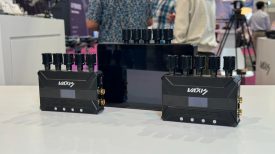Drones have never been particularly good at flying in inclement weather conditions, or in super cold temperatures. Most commercially available drones normally come with a recommendation in their operations manual not to fly in severe weather conditions. These include wind speeds exceeding 10 m/s, snow, rain and fog. To solve this problem DJI have unveiled the new Matrice 200 drone series (M200).
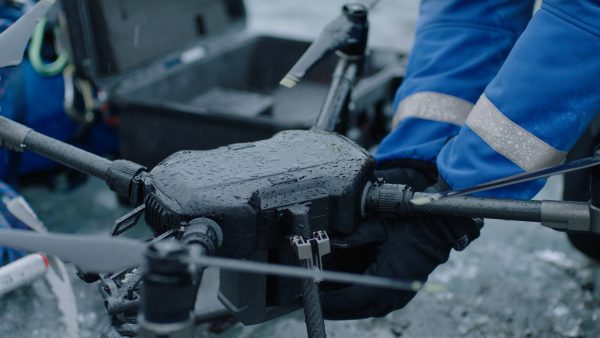
The M200 series’ features a weather- and water-resistant body, that makes it ideal for use in all sorts of environmental conditions. The M200 has primarily been designed for use in industrial applications and it offers DJI’s first upward-facing gimbal mount, which allows the drone to see things such as the undersides of bridges, towers and other structures. It is compatible with DJI’s X4S and X5S cameras, as well as the high-powered Z30 zoom camera and the XT camera for thermal imaging. It has a forward-facing first-person view camera, allowing a pilot and a camera operator to monitor separate images on dual controllers. Its safety features include obstacle avoidance sensors facing forward, up and down, as well as an ADS-B receiver for advisory traffic information from nearby manned aircraft. With a dual battery set-up, the M200 platform can fly for up to 35 minutes with a mounted camera.
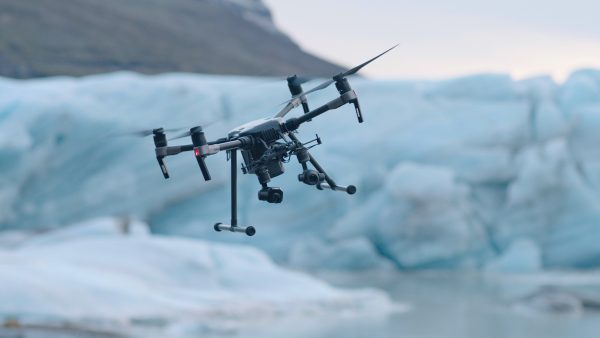
While the M200 series is very much targeted towards industrial applications there is no reason why filmmakers couldn’t use the drone to capture footage in adverse weather conditions.
The M200 series’ computer vision enables the following intelligent flight modes:
Spotlight – to lock the camera onto a subject during flight while the aircraft moves freely
Point of Interest – to circle around an object for a smooth orbit
Tripod – to fine-tune position and angle for position framing and safe navigation in narrow environments
ActiveTrack – to follow a person or object while keeping it in frame
Two battery versions – a standard 95 Wh version and a more powerful version of 174 Wh with flight time of up to 38 minutes are available.
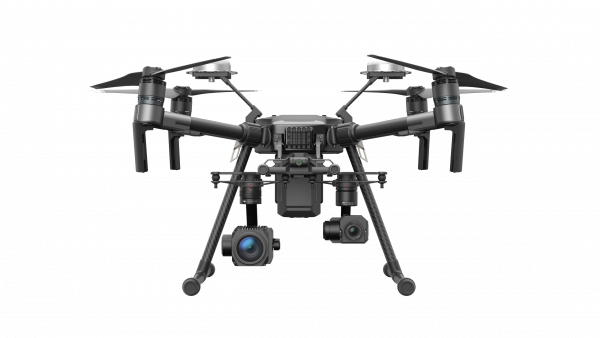
The M200 series enables three different payload configurations – one downward-facing camera (M200), two downward-facing cameras (M210) and / or one upward-facing cameras (M210).
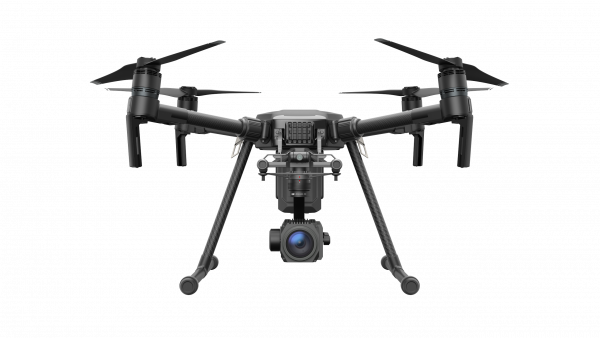
The M200 series comes in three versions. The standard M200 is equipped with one downward-facing gimbal mount. The M210 opens up for multiple payload configurations – one single downward facing gimbal mount, two parallel downward-facing gimbal mounts or one upward-facing gimbal mount. The M210 features additional connectivity ports to support third party sensors and accessories. The M210 has the capability to support additional sensors in the future and additional payload can be mounted on top of the aircraft. The M210 RTK is available with D-RTK modules for centimeter-precision navigation.
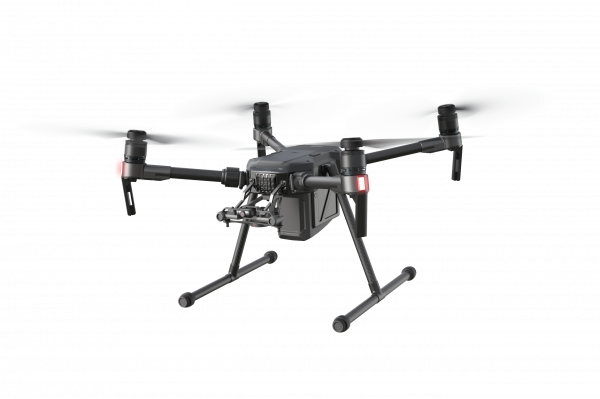
With an IP43 classification, the M200 series is built to endure adverse environments. The aircraft is equipped with more than 20 internal sensors for maximum redundancy and reliability, including compass, GPS system, dual inertial measurement units (IMUs) and three barometers. Gimbal controllers have been integrated in the aircraft body for protection and to prevent drift. The aircraft features two stereo-vision systems below and in front of the aircraft and has an upward facing infrared sensor for obstacle avoidance. A redundant battery system improves safety and also allows the craft to stay powered while batteries are swapped in sequence.
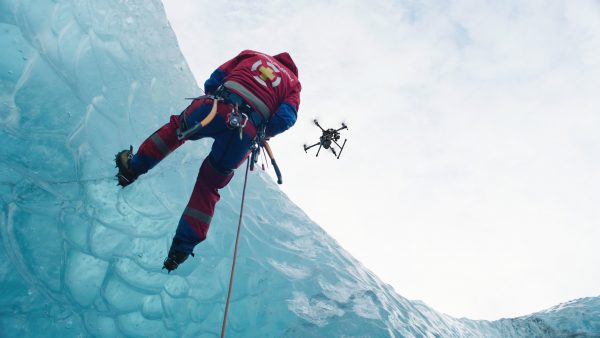
The M200 series features DJI AirSense, a built-in ADS-B receiver, enhancing airspace safety by automatically providing the operator with real-time information about the position, altitude, and velocity of nearby manned aircraft equipped with ADS-B transmitters. AirSense enables safer and more efficient use of airspace, particularly in locations where other manned aircraft may be operating.
The M200 series is also equipped with an integrated flight controller, featuring two IMUs and a GNSS unit, with additional analytical redundancy systems. Working together with advanced diagnostic algorithms, it can seamlessly switch from one IMU to the other to maintain reliability and precision.
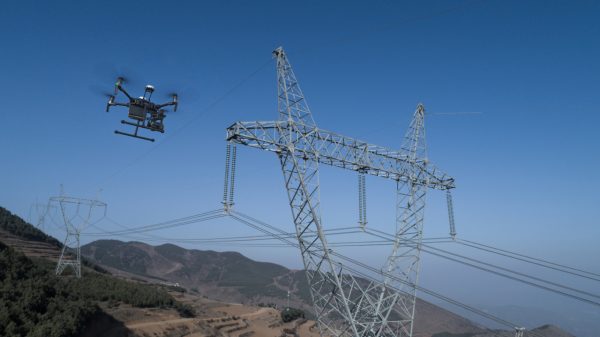
The M200 series uses DJI’s powerful Lightbridge 2 system, supporting a range up to 4.3 miles (7 km) where, allowed by local laws and regulations, at live view resolutions up to 1080p. The master and slave controller range extends to 328 feet and users can switch between 2.4 GHz and 5.8 GHz frequencies to cut through any noise for greater signal stability.
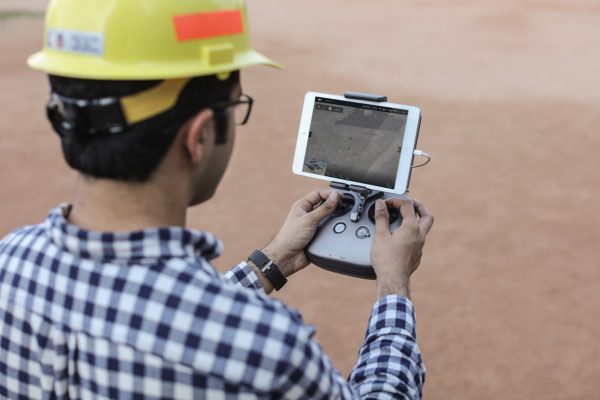
In addition to the DJI GO 4 app, the M200 series supports the brand new DJI Pilot app, which is specifically designed for enterprise users, optimizing user experience and flight performance. Users can also plan flights through DJI’s GS Pro app, which uses a clear and concise interface to establish complex flight missions with just a few taps.
The M200 series is compatible with DJI’s Mobile and Onboard Software Development Kit (SDK), enabling programmers to build customized solutions for flight planning, data collection and analysis.
The DJI Pilot app is compatible with DJI FlightHub™, a web-based software package allowing teams to share real-time data with offsite parties over the Internet. This includes remote emergency situation control rooms keeping track of first response teams or asset management centers inspecting global infrastructure networks. In an easy-to-use control center, DJI FlightHub lets users plan flights with multiple drones and keep track of each aircraft’s status. An offsite control room can simultaneously monitor live feeds and can remotely control gimbal and camera. The software enables managers to plan flights in advance using waypoints and dynamic geofencing.
Price and Availability
The M200, the M210 and the M210 RTK are available for pre-order from official DJI Enterprise dealers and will start shipping in Q2 2017. Pricing details and information on where to buy the M200 series will be announced in due course. For more information about the M200 series, please see here: http://www.dji.com/matrice-200-series/

AIRCRAFT SPECIFICATIONS
Model M200
Package Dimensions 790mm*390mm*290mm
Dimensions (unfolded) 887mm*880mm*378mm
Dimensions (folded) 716mm*220mm*236mm
Folding Method Fold Inward
Diagonal Wheelbase 643mm
Number of Batteries 2
Weight (TB50) 3.80KG
Weight (TB55) 4.53KG
Max Takeoff Weight 6.14KG
Max Payload (TB50) 2.34KG
Max Payload (TB55) 1.61KG
Hovering Accuracy (during safe flights) P Mode: 35°(Forward Vision System enabled: 25°); A Mode: 35°;S Mode: 35°
Horizontal: ±1.5,Downward Vision System enabled: ±0.3
Max Angular Velocity Pitch: 300° /s;Yaw: 150° /s
Max Pitch Angle P Mode: 35°(Forward Vision System enabled: 25°); A Mode: 35°;S Mode: 35°
Max Ascent Speed P Mode / A Mode / S Mode: 5 m/s
Max Descent Speed Vertical: 3 m/s
Max Speed S Mode 23m/s P
Mode 17m/s
A Mode 23m/s
Max Service Ceiling Above Sea Level 1.55 mi (2500 m)
Max Wind Resistance 10m/s
Max Flight Time(No Payload, with TB50) 27min
Max Flight Time(No Payload, with TB55) 38min
Max Flight Time(6kg Payload, with TB50) 13min
Max Flight Time(6kg Payload, with TB55) 24min
Motor Model DJI 3515
Propeller Model 1760S
Landing Gear Quick-release
Operating Temperature -20°C to 45° C
IP Rating IP43
GIMBAL INSTALLATION
Downward Gimbal Mount Supported
Upward Gimbal Mount Not Supported
Downward Dual Gimbal Not Supported
BATTERY (STANDARD)
Model TB50
Capacity 4280 mAh
Voltage 22.8V
Battery Type LiPo 6S
Energy 97.58 Wh
Net Weight 520g
Operating Temperature -20°C to 40° C
Storage Temperature Less than 3 months: -20° C to 45° C
More than 3 months: 22° C to 28° C
Charging Temperature 5 ℃ to 40 ℃
Max Charging Power 180 W
CHARGER
Model IN2C180
Voltage 26.1 V
Rated Power 180 W
FORWARD VISION SYSTEM
Obstacle Sensing Range 0.7 – 30 m;
FOV Horizontal 60°,Vertical 54°
Operating Environment Surfaces with clear patterns and adequate lighting (> 15 lux)
DOWNWARD VISION SYSTEM
Velocity Range <32.8 ft/s (10 m/s) at height of 6.56 feet (2 m)
Altitude Range <10 m
Operating Range <10 m
Operating Environment Surfaces with clear patterns and adequate lighting (> 15 lux)
Ultrasonic Sensor Operating Range 10 – 500 cm
Ultrasonic Sensor Operating Environment Non-absorbing material, rigid surface (thick indoor carpeting will reduce performance)
GIMBAL
ZENMUSE X4S
Zenmuse X5S
Zenmuse Z30
Zenmuse XT
BATTERY (OPTIONAL)
Model TB55
Capacity 7760 mAh
Voltage 22.8V
Battery Type LiPo 6S
Energy 176.93Wh
Net Weight 约885g
Operating Temperature -20°C 至 40° C
Storage Temperature “Less than 3 months: -20° C to 45° C
More than 3 months: 22° C to 28° C”
Charging Temperature 5 ℃ to 40 ℃
Max Charging Power 180 W
UPWARD INFRARED SENSOR
Obstacle Sensing Range 0 – 5 m
FOV ±5°
FOV Large-sized object with diffuse relecting surface or high relective rate (>10%)
AIRCRAFT
Model M210
Package Dimensions 790mm*390mm*290mm
Dimensions (unfolded) 887mm*880mm*378mm
Dimensions (folded) 716mm*220mm*236mm
Folding Method Fold Inward
Diagonal Wheelbase 643mm
Number of Batteries 2
Weight (TB50) 3.84KG
Weight (TB55) 4.57KG
Max Takeoff Weight 6.14KG
Max Payload (TB50) 2.3KG
Max Payload (TB55) 1.57KG
Hovering Accuracy (during safe flights) Vertical: ±0.5,Downward Vision System enabled: ±0.1
Horizontal: ±1.5,Downward Vision System enabled: ±0.3
Max Angular Velocity Pitch: 300° /s;Yaw:150° /s
Max Pitch Angle P Mode: 35°(Forward Vision System enabled: 25°); A Mode: 35°;S Mode: 35°
Max Ascent Speed P Mode / A Mode / S Mode: 5 m/s
Max Descent Speed Vertical: 3 m/s
Max Speed S Mode 23m/s P Mode 17m/s A Mode 23m/s
Max Service Ceiling Above Sea Level 1.55 mi (2500 m)
Max Wind Resistance 10m/s
Max Flight Time(No Payload, with TB50) 27min
Max Flight Time(No Payload, with TB55) 38min
Max Flight Time(6kg Payload, with TB50) 13min
Max Flight Time(6kg Payload, with TB55) 24min
Motor Model DJI 3515
Propeller Model 1760S
Landing Gear Quick-release
Operating Temperature -20°C to 45° C
IP Rating IP43
GIMBAL INSTALLATION
Downward Gimbal Mount Supported
Upward Gimbal Mount Supported
Downward Dual Gimbal Supported
BATTERY (STANDARD)
Model TB50
Capacity 4280 mAh
Voltage 22.8V
Battery Type LiPo 6S
Energy 97.58 Wh
Net Weight 520g
Operating Temperature -20°C to 40° C
Storage Temperature “Less than 3 months: -20° C to 45° C
More than 3 months: 22° C to 28° C”
Charging Temperature 5 ℃ to 40 ℃
Max Charging Power 180 W
CHARGER
Model IN2C180
Voltage 26.1 V
Rated Power 180 W
FORWARD VISION SYSTEM
Obstacle Sensing Range 0.7 – 30 m;
FOV Horizontal 60°,Vertical 54°
Operating Environment Surfaces with clear patterns and adequate lighting (> 15 lux)
DOWNWARD VISION SYSTEM
Velocity Range <32.8 ft/s (10 m/s) at height of 6.56 feet (2 m)
Altitude Range <10 m
Operating Range <10 m
Operating Environment Surfaces with clear patterns and adequate lighting (> 15 lux)
Ultrasonic Sensor Operating Range 10 – 500 cm
Ultrasonic Sensor Operating Environment Non-absorbing material, rigid surface (thick indoor carpeting will reduce performance)
COMPATIBLE GIMBALS
ZENMUSE X4S
Zenmuse X5S
Zenmuse Z30
Zenmuse XT
BATTERY (OPTIONAL)
Model TB55
Capacity 7760 mAh
Voltage 22.8V
Battery Type LiPo 6S
Energy 176.93Wh
Net Weight 885g
Operating Temperature -20°C to 45° C
Storage Temperature “Less than 3 months: -20° C to 45° C
More than 3 months: 22° C to 28° C”
Charging Temperature 5 ℃ to 40 ℃
Max Charging Power 180 W
UPWARD INFRARED SENSOR
Obstacle Sensing Range 0 – 5 m
FOV ±5°
Operating Environment Large-sized object with diffuse relecting surface or high relective rate (>10%)
M210-RTK
AIRCRAFT
Model M210-RTK
Package Dimensions 790mm*390mm*290mm
Dimensions (unfolded) 887mm*880mm*408mm
Dimensions (folded) 716mm*242mm*236mm
Folding Method Fold Inward
Diagonal Wheelbase 643mm
Number of Batteries 2
Weight (TB50) 4.27KG
Weight (TB55) 5.0KG
Max Takeoff Weight 6.14KG
Max Payload (TB50) 1.87KG
Max Payload (TB55) 1.14KG
Hovering Accuracy (during safe flights) Vertical: ±0.5,Downward Vision System enabled: ±0.1
Horizontal: ±1.5,Downward Vision System enabled: ±0.3
Max Angular Velocity Pitch: 300° /s;Yaw:150° /s
Max Pitch Angle P Mode: 35°(Forward Vision System enabled: 25°); A Mode: 35°;S Mode: 35°
Max Ascent Speed P Mode / A Mode / S Mode: 5 m/s
Max Descent Speed Vertical: 3 m/s
Max Speed S Mode 23m/s
P Mode 17m/s A
Mode 23m/s
Max Service Ceiling Above Sea Level 1.55 mi (2500 m)
Max Wind Resistance 10m/s
Max Flight Time(No Payload, with TB50) 23min
Max Flight Time(No Payload, with TB55) 32min
Max Flight Time(6kg Payload, with TB50) 13min
Max Flight Time(6kg Payload, with TB55) 24min
Motor Model DJI 3515
Propeller Model 1760S
Landing Gear Quick-release
Operating Temperature -20°C to 45° C
IP Rating IP43
GIMBAL INSTALLATION
Downward Gimbal Mount Supported
Upward Gimbal Mount Supported
Downward Dual Gimbal Supported
BATTERY (STANDARD)
Model TB50
Capacity 4280 mAh
Voltage 22.8V
Voltage LiPo 6S
Energy 97.58 Wh
Net Weight 520g
Operating Temperature -20°C to 40° C
Storage Temperature “Less than 3 months: -20° C to 45° C
More than 3 months: 22° C to 28° C”
Charging Temperature 5 ℃ to 40 ℃
Max Charging Power 180 W
CHARGER
Model IN2C180
Voltage 26.1 V
Rated Power 180 W
FORWARD VISION SYSTEM
Obstacle Sensing Range 0.7 – 30 m;
FOV Horizontal 60°,Vertical 54°
Operating Environment Surfaces with clear patterns and adequate lighting (> 15 lux)
DOWNWARD VISION SYSTEM
Velocity Range <32.8 ft/s (10 m/s) at height of 6.56 feet (2 m)
Altitude Range <10 m
Operating Range <10 m
Operating Environment
Surfaces with clear patterns and adequate lighting (> 15 lux)
Surfaces with clear patterns and adequate lighting (> 15 lux) 10 – 500 cm
Ultrasonic Sensor Operating Environment Non-absorbing material, rigid surface (thick indoor carpeting will reduce performance)





